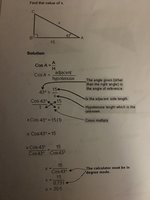Paul938271849
New member
- Joined
- Aug 9, 2020
- Messages
- 2
I’m trying to help a friend who’s doing grade 10 math, but I myself don’t know some of the parts to the equation.
The question they wish to know, is why do you bring down cos43 for the fraction near the end? We understand it’s to cancel it out, but I guess we don’t know how or why that step occurs I guess. This question may be a fraction question more then a trig question, but we are just confused how or why that step occurs, and how would you know to do that? What aren’t we understanding about that step? Thank you for any help we can get with that.
The question they wish to know, is why do you bring down cos43 for the fraction near the end? We understand it’s to cancel it out, but I guess we don’t know how or why that step occurs I guess. This question may be a fraction question more then a trig question, but we are just confused how or why that step occurs, and how would you know to do that? What aren’t we understanding about that step? Thank you for any help we can get with that.

